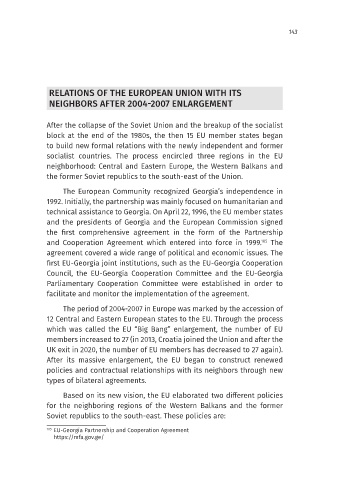Page 144 - SEVEN STEPS for COMPREHENDING the EUROPEAN UNION
P. 144
143
RELATIONS OF THE EUROPEAN UNION WITH ITS
NEIGHBORS AFTER 2004-2007 ENLARGEMENT
After the collapse of the Soviet Union and the breakup of the socialist
block at the end of the 1980s, the then 15 EU member states began
to build new formal relations with the newly independent and former
socialist countries. The process encircled three regions in the EU
neighborhood: Central and Eastern Europe, the Western Balkans and
the former Soviet republics to the south-east of the Union.
The European Community recognized Georgia’s independence in
1992. Initially, the partnership was mainly focused on humanitarian and
technical assistance to Georgia. On April 22, 1996, the EU member states
and the presidents of Georgia and the European Commission signed
the first comprehensive agreement in the form of the Partnership
105
and Cooperation Agreement which entered into force in 1999. The
agreement covered a wide range of political and economic issues. The
first EU-Georgia joint institutions, such as the EU-Georgia Cooperation
Council, the EU-Georgia Cooperation Committee and the EU-Georgia
Parliamentary Cooperation Committee were established in order to
facilitate and monitor the implementation of the agreement.
The period of 2004-2007 in Europe was marked by the accession of
12 Central and Eastern European states to the EU. Through the process
which was called the EU “Big Bang” enlargement, the number of EU
members increased to 27 (in 2013, Croatia joined the Union and after the
UK exit in 2020, the number of EU members has decreased to 27 again).
After its massive enlargement, the EU began to construct renewed
policies and contractual relationships with its neighbors through new
types of bilateral agreements.
Based on its new vision, the EU elaborated two different policies
for the neighboring regions of the Western Balkans and the former
Soviet republics to the south-east. These policies are:
105 EU-Georgia Partnership and Cooperation Agreement
https://mfa.gov.ge/

